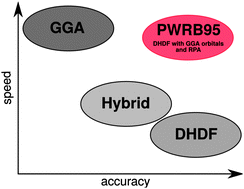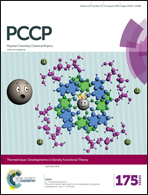A computationally efficient double hybrid density functional based on the random phase approximation†
Abstract
We present a revised form of a double hybrid density functional (DHDF) dubbed PWRB95. It contains semi-local Perdew–Wang exchange and Becke95 correlation with a fixed amount of 50% non-local Fock exchange. New features are that the robust random phase approximation (RPA) is used to calculate the non-local correlation part instead of a second-order perturbative treatment as in standard DHDF, and the non-self-consistent evaluation of the Fock exchange with KS-orbitals at the GGA level which leads to a significant reduction of the computational effort. To account for London dispersion effects we include the non-local VV10 dispersion functional. Only three empirical scaling parameters were adjusted. The PWRB95 results for extensive standard thermochemical benchmarks (GMTKN30 data base) are compared to those of well-known functionals from the classes of (meta-)GGAs, (meta-)hybrid functionals, and DHDFs, as well as to standard (direct) RPA. The new method is furthermore tested on prototype bond activations with (Ni/Pd)-based transition metal catalysts, and two difficult cases for DHDF, namely the isomerization reaction of the [Cu2(en)2O2]2+ complex and the singlet–triplet energy difference in highly unsaturated cyclacenes. The results show that PWRB95 is almost as accurate as standard DHDF for main-group thermochemistry but has a similar or better performance for non-covalent interactions, more difficult transition metal containing molecules and other electronically problematic cases. Because of its relatively weak basis set dependence, PWRB95 can be applied even in combination with AO basis sets of only triple-zeta quality which yields huge overall computational savings by a factor of about 40 compared to standard DHDF/‘quadruple-zeta’ calculations. Structure optimizations of small molecules with PWRB95 indicate an accurate description of bond distances superior to that provided by TPSS-D3, PBE0-D3, or other RPA type methods.

- This article is part of the themed collection: Developments in Density Functional Theory

 Please wait while we load your content...
Please wait while we load your content...